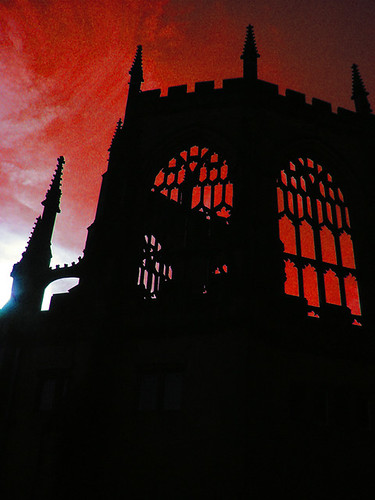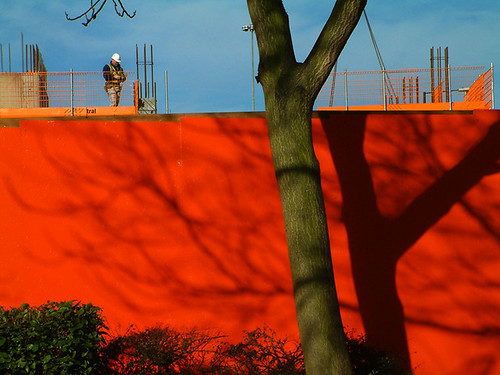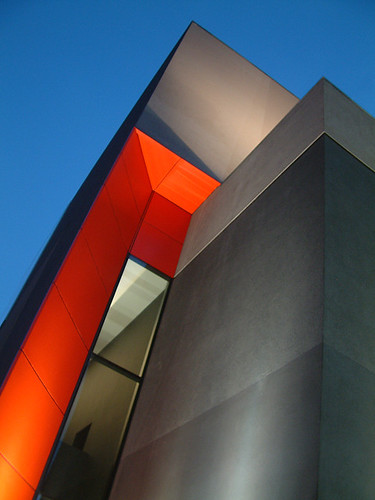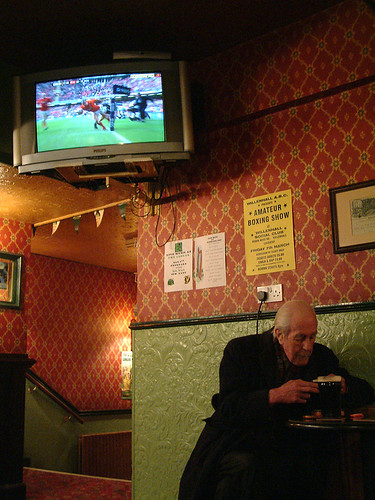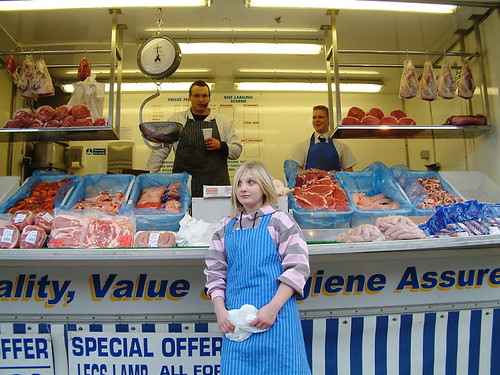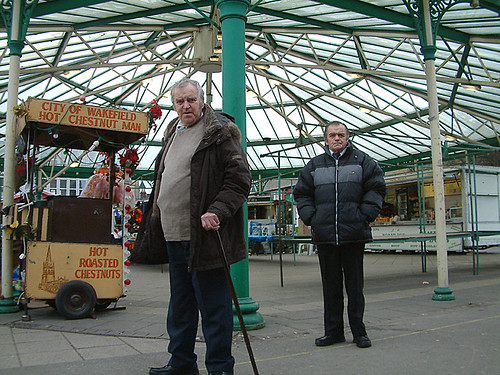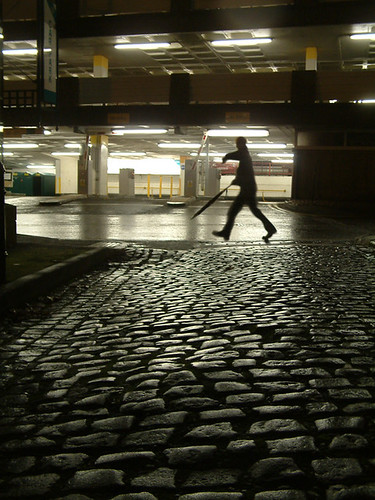Friday, 13 February 2009
In The Eye Of The Storm. Day 4. New Vic. 9/2/09
After defying the weather since Thursday, laughing in the face of snow and ice and gales while the rest of the country ground to a halt, it all finally caught up with us on the way home tonight. Our last show on the tour. The M6 and M1 were very difficult, but Thanks to Gordon, we all made it in one piece. Thanks to Renae, the shows were lit and stage managed, and this video shot.
In The Eye Of The Storm
Thursday, 12 February 2009
Day 3. Peña Flamenca de Londres. 8/2/09
Just a full house for our first time at the Peña.
Thanks to Vera.
.jpg)
In The Eye Of The Storm
Tour Company: Ana de los Reyes. Mateo Solea, La Joaquina, Gemma de la Cruz, Rosa de las Heras, Chris Mullett, Jesus Alvarez.
In The Eye Of The Storm. Day 2. Artrix 7/2/09
By Artrix today, the conditions are easier. And the audience doesn't have to wear its overcoats. Nevertheless, we are still surrounded on all sides by blizzards and icebound roads and closed schools and five mile queues behind jack-knifed lorries.
Roses and Luck and Snow. Day 1. 6/2/09
Mateo and Ana and Jesus managed to scramble in to Stansted in between snowshowers at 11.50 last night. By this morning it was snowbound again, and Luton, which is not that far away, was totally isolated.
The snow hit at just the right places and times for us last night, and the same is happening today. We were chased away from Stansted by it last night, and out of London by it today into the effects of last night's storms in the west country. It's as if we're in the eye of the storm.
To the south and north of Tewkesbury winter chaos reigns. Both Severn bridges closed. The M5 at a standstill. And Oxfordshire enjoying blizzard conditions.
And yet we slid effortlessly along the M40 due to the lack of traffic, and hit Tewkesbury in record time. The trip from The Roses to the digs in Cheltenham tonight, and the trip to Bromsgrove tomorrow - and home again - may be a different story.
In The Eye Of The Storm
There's No Business Like Snow Business. 4/2/09
 We don't know yet, but some of this weekend's gigs might be under threat from the lovely snow.
We don't know yet, but some of this weekend's gigs might be under threat from the lovely snow.And naturally, most of the bookings are looking healthy, and in one, a local enthusiast has gone to immense trouble and expense to prepare food and socialising for after the show..
It's always the way with cancellations.
So today has been about having 'conversations' with venue managers about the possible dangers - if there are any, which we hope there won't be because I'm just panicking - which I hope I am.
It's all very well for those on the sidelines to urge that 'The Show Must Go On', but after all the snowballs have been thrown, this weather is going to effect the flamenco business just like any other. And the venues artists perform in. And the awful truth is that we won't know what the best decision is until it's too late to take it..
As the famous song goes on to say:
We have people coming in to three different airports. Which is either good or bad, I can't decide which. All the singers and a guitarist are are arriving at Stanted. If that is clear, we could put on a show, but only with one dancer. If it isn't clear, we've no show at all. And all the permutations in between. Either way we need all three to be clear to have a full company.
Maybe the era of cheap-flight based mini-tours is coming to an end.
In The Eye Of The Storm
Bridport 13/9/08
Swan Theatre, Worcester Festival. 25/8/08
This was our fifth performance at the Swan since 2001, and was as well-managed as ever. Thanks to technicians Matt and Emma, and all the front of house staff for loving their work.



New Theatre Royal, Portsmouth. 24/6/08
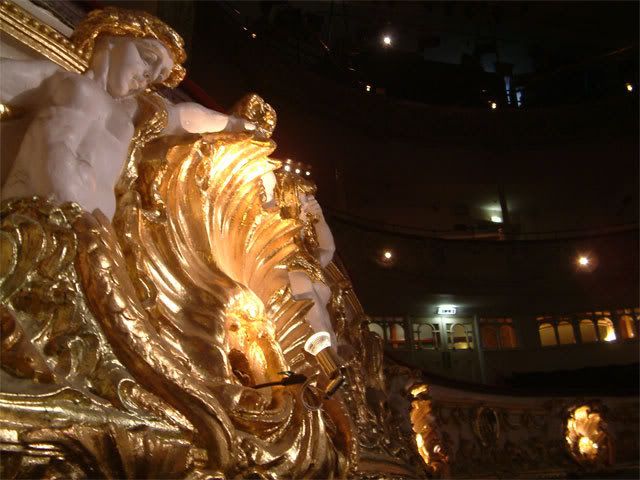
Rehearsal

Buleria.

"A small company of three dancers and four musicians filled the stage as if they were performing at a much bigger location yet kept intact the intimacy of the venue.
With a programme of traditional flamenco performed with unconventional interpretations, they managed to transport the audience not to the tacky Spanish holiday resorts of the 1970s but to the darker heart of the Iberian gipsy soul.
The dances were packed full of energy (exhausting the audience as much as the performers) and displayed impeccable precision and timing. Mention must be given to guitarist Jesus Alvarez whose dexterity and musicianship were stunning."
Portsmouth News

The sad, fiery history of The Theatre Royal, as revealed by the missing half. This image was taken from approximately the position of the original backstage wall. The entire original stage, flytower and dressing rooms being destroyed in the fire of 1972.
The magnificent efforts of the theatre team over the years has not only reopened the house as a working venue, but also restored much of the decoration and fittings of the beautiful Matcham interior, one of the best acoustic spaces in British regional theatre, in our experience.
Thanks to Heather, Mike and all the team for making the day very simple, straightforward and creative.
Flamenco Express have played NTR five times since 1998, and it was obvious from the start that here was a venue which might have been made for flamenco. Apart from the acoustics, the intimacy of the galleries - as in all Matcham theatres - is a genuine aid to the performers, as is the spirituality of the vaulted auditorium.
The stage as a tablao - as a sounding board for flamenco purposes, is also excellent. Deep and crisp and even. June the twenty fourth wasn't the feast of St Stephen, but the NTR shone brightly that night, as it always does for us.
From an entirely selfish point of view, the added bonus of the NTR, compared with most other Matcham theatres, is the fact that because the only stage is the old forestage, there is no rake, which can sometimes be troublesome for our dancers. This is a direct result of the fire - and if that doesn't make the NTR a bona fide flamenco theatre, I can't think what does. It is a building which has suffered, and which was reborn out of fire through improvisation and determination. It doesn't take a gigantic suspension of disbelief for the audience and performer to tune in together to the spirit of such a space and relax into the business of making theatre.
Hopefully, when the final restoration is complete, it will stay same, only better.
Queen's Theatre, Hornchurch.23/06/2008

Silky slick efficiency from the entire team at the Queen's, from booking the date through the marketing operation to the performance of the technicians. Thanks to Jim and Alex, and to the front of house team.
Our first visit and hopefully not our last.
And an audience which knew really how to enjoy itself. And a modern audirorium with a crisp but warm acoustic, and a lively stage. And from a personal point of view, a theatre in which a journey from the dressing rooms to the front of house didn't invariably end up in the car park - which can happen.
All this plus an ecological signature species for a theatre pet.



© flamenco express 2008
Pavilion Theatre Worthing. 22/06/08

Another of the many pretty little theatres on the British regional circuit. Performing over the sea in a high wind was a new experience for most of the company, but the sheer gentility and elegance of the Pavilion seemed to defy the storm with sheer style, and the howling wind was tamed to provide a perfect soundscape for the timeless passion of flamenco. The music inside the theatre was as intense as the raging wind outside. God was our FX man that night.
Thanks to Jim and Roy for doing everything He couldn't.
And to make the night almost perfect, Spain beat Italy in the semi-finals of Euro 2008. We had tried, with some determination, to book an Italian restaurant for supper after the show, where we could share the second half in a culturally meaningful way. But all in vain. All were closed. And don't think we don't know why. Vergogna sugli ospiti di Worthing. To have sipped Sambuca dei Cesari as the winning penalty sliced home would have been perfection. For us, anyway.
In the end we had to make do with a very nice pub, followed by a very nice Indian restaurant. But it wasn't the same.
---------------------------------------------------------------------------------
Pavilion Theatre, Worthing. 22/06/2008
Jesus at the half hour.

Seafront Worthing


Taking Shelter

Little Theatre, Sheringham. 24/05/2008
Someone once said that civilisation could be summd up in the word 'welcome'.
The Little Theatre, Sheringham may well be little, but it is very civilised.


Laban 7/4/08
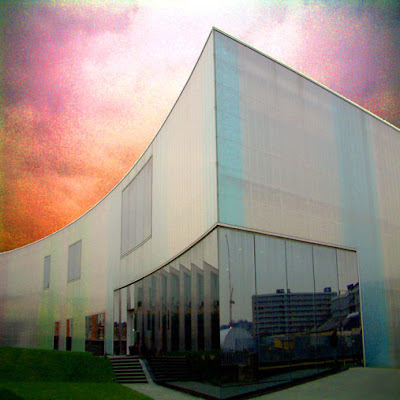
'POWERFUL GRACE and DYNAMIC RHYTHM' by Megan Millar-McKeever for Remotegoat
Passion, drama, and hot summer nights. These are the things that come to mind when one thinks of flamenco dancing. What Flamenco Express added to this list of attributes was grace, strength and humour. If you have never been exposed to flamenco dancing before seeing this company perform is a great place to start, and if you are a connoisseur then you are guaranteed to have an enjoyable evening.
This small company, comprised of four dancers and four musicians, created a dynamic performance last Thursday night at the LABAN Theatre. The female dancers began the evening with a vibrant group piece, followed by a series of solo performances. Their steps provided a rhythm for the music created by the sweet sounds of the acoustic guitarists and the rough vocals of the singers. Through the performance the music built in speed and intensity seducing the listener while the dancers captivated with their powerful grace.
The impression the performers left on the audience was apparent as members of the audience rose to their feet applauding and children tapped away in the isles in an attempt to mimic what they had just seen. If you love dance, Spain or listening to a wicked acoustic guitar this show is a definite must see. I had a fantastic time and would recommend it to anyone.
Remotegoat. 2008
Thanks as usual to Faye and the crew at The Bonnie Bird Theatre.
Devonshire Park Theatre, Eastbourne. 29/3/08
It is one of the best examples of small Victorian Theatre in the country with ornate interior featuring decorative plaster work with scrolls and caryatids by Schmidt of Holloway. The theatre won the Martini/TMA Regional Theatre Award for ‘Most Welcoming Theatre’ in 1994.
Attendance: 460.
Stage crew - excellent. Front of House - excellent. Stage - slightly more rake than flamenco likes, but not too bad and otherwise a sound tablao. Acoustics - fabulous.
Tour Company: Ana de los Reyes. Mateo Solea, La Joaquina, Gemma de la Cruz, Rosa de las Heras, Chris Mullett, Jesus Alvarez.


Theatre Royal Wakefield. 26/1/08
Corn Exchange, Bedford. 23/11/07

© flamenco express 2007
'Bedford Art-icle'.
www.articlemagazinebedford.org.uk
The first time I saw a Flamenco dance troop was in 1995 in a small crowded bar in Barcelona. There were only four in the company; a singer, a guitarist and male and female dancers. They sang, played and danced for an hour and a half without a break. The atmosphere in the confines of the bar was hot, steamy and intimate. The performance was done with vigour, artistry and passion, faces contorted with expression, communicating all the anguish, pain, joy and other emotions of the story. Performers and audience alike with beads of sweat dripping from the forehead, down the sides of the face and off the ends of noses and chins. Indeed, the singer was almost crying. It was electric.
Upon reflection I concluded that Flamenco is far more than just a dance. It is a way of life.
My second outing was some years later in the sterile atmosphere of a large concert hall in Munich. The performance inevitably succumbed to the atmosphere of the hall. Technically superb, but sterile.
Flamenco Express laid out their credentials immediately with the opening number which involved the entire company. They trooped onto the floor and commenced without introduction. The powerful voice of Ana de los Reyes boomed out across the rows of an expectant Bedford audience. The flowing skirts of the dancers, the staccato strumming of the guitar, the rhythmical clapping and the sharp, high speed tap, tap tapping of the feet brought it all flooding back.
With eyes closed the performance evoked all the memories and emotion of that bar in Barcelona. The performers doing well to counter the somewhat flat atmosphere of the Corn Exchange. Even without the heat, the intimacy and the sweat, Flamenco Express were never-the-less, as far as I was concerned, the real deal. Highly recommended.
© Manoj Gupta 2007
On The Road.
The artists need to eat, the technicians need to begin pointing the lights in the right direction. Again, everything is going according to plan, specifically, the lighting plan mailed to the theatre some days before. The technician is ready in the Tallescope dark and begins his wrestling match with the burning lights, which seem to have a life of their own.
'Downstage... Left...OK.'
'OK? Move me on Mike.' - The jargon is not very colourful.
The singers and guitarists arrive to tease the best sound possible from the building, allowing in advance for the dampening effect of the audience. If it is a plaster-laden rococo wedding cake like one of Matcham's masterpieces, we are in clover. But some of the more minimalist halls are a little colder and even less predictable. An experienced resident sound technician is invaluable in those circumstances.
The red and blue and green Xmas deeley lights flicker on the desk.
'More reverb... A bit more volume in the monitors....' - Not quaint, but effective.
Setting the sound for flamenco is very exacting and often seems to be dicing with feedback. Requests sometimes raise eyebrows from technicians in first-time flamenco houses.
The dancers take the stage. Where are the hollow spots, the sweet spots, the dead spots? How slippery? Which light can I use to spot my turns? Where do I exit? -
"No - this is when I begin my footwork.."
The rehearsal is over. The Half Hour ticks by. The house lights go down, the audience glitters expectantly, the first beats of the opening martinete sound out, there is no escape now, the show is under way in the usual blur of sound and lights and heart and adrenalin and scrambles for the interval drinks.
British audiences are reaching flamenco in new ways. Many now come because of their YouTube discoveries rather than to relive Costa Del Sol night club memories. And there are now many more authentic jaleos from the average regional audience than ever. More Spanish people are living and working in Hull and Bristol and Tewkesbury. And more British young people are hearing flamenco. With the help of the most modern technology, one of the most essentially primal artforms is spreading and growing. Which is how it should be.
The show is over, and everyone is sweating. Which, again, is how it should be. Everyone needs more water, and time to readjust from the stage high, and to talk without the performance looming overhead, and very soon something to eat. A french musician comes to the stage door to invite us to a local club where there is Gypsy jazz until 3. We would love to, but simply can't. We have left all our energy onstage, and we have to do so again tomorrow for our paying audience. Or we have to be on planes to Madrid or Jerez.
This particular outing began a year ago with an email to a database entry, and is nearly over. This time, there were no problems. It was a typical, non-eventful, efficient day's artistic creation. Sometimes, believe it or not, things can be quite different.
On The Road 3. Cork. 24/4/02.
We arrive with a splash into Ireland. ‘Thank God - You lads have brought the rain with you.’ says the taxi driver, with a completely straight face. We tell him why we’re here. ‘The Opera House? A fine theatre. Now you boys mind you don’t go to any of those wicked pubs, and have a nice time in Cork.’ It is genuinely difficult to be politically correct to such a place.
We do go to some of those wicked pubs I’m afraid - but strictly on the business of promoting tomorrow’s show. We have various competitions organised through the venue and by local radio presenter and fiddler Eoghan Neff. We end up playing and singing with two local singers, a guitarist and three fiddlers, who swap instruments between choruses. Irish-blues-flamenco fusion. Some delirious fool delivers a high-folk acapella rendition of Yeats’ ‘Song of the Wandering Aengus’. No chairs are thrown, not least by me. From where I am it sounds great.... But then it would. What a place to do business.
We get back to the hotel. A nightcap is called for, since we’ve worked hard, and didn’t get much time for drinking. Just before I get up to order, the barman comes over and says: “I’m off home now lads. Help yourselves.”
This, apparently, is Cork. I want to eat it all up. Cork definitely awakes something in the flamencos from Jerez. The constant music-making reminds them of home. And they instantly sense that the audience at The Opera House is fantastically open and warm and receptive and encouraging, and that means a lot. The technicians are alert and inventive. And the front-of-house staff bring the company refreshments without being asked. They take an interest. As the man said: ‘A fine theatre’.
A fine town too. The Jerez of the North, if you like. Forget swimming with squeaky dolphins before you die, Cork is far more fun, but not necessarily drier.
On The Road 2. Wilderness Night.
We eventually crammed everything into the van around the baby buggy and drove off merrily into the night. "Be home by 12.30", I remember thinking.
Half an hour later we were sitting by the side of the A46 looking at the stars and waiting for the recovery truck to come. We had begged to stop because of the terrible smell in the van. At first I hadn't noticed it, being up front, or I assumed it was just the baby. But then even I had to admit that something was on fire and we had to do something quick.
We pulled up in a lay-by behind a parked car-transporter and looked under the van. The exhaust pipe had broken off and was leaking gas into the cab. We called the breakdown service and waited... And waited.... And waited.
Three hours later we were still waiting. Everyone was being very British about it, really. We didn't start blaming each other or bursting into tears or shouting . There were no snivelling Richard Attenboroughs writhing in the bottom of the van trying to steal the last of the rations. There were no rations to steal.
Instead, we all followed the baby's example and tried to get some kip. I was in agony already. My legs were crammed up against the dashboard like something dreamed up by Torquemada.
The driver of the recovery truck was having problems finding us. We kept telling him where we were. Or rather, where we thought we were. The trouble was we weren't there. Even though we thought we were.
The van started to get cold, the battery was running down from having to have the lights on. The baby kept waking up and crying. The seats kept getting harder. Visions of corrugated iron sheeting kept swimming in and out of my fuddled mind. I was wrapping myself up in it to keep warm and cosy. It seemed like a blessed relief. We ran out of water, pear drops and cigarettes. I don't think any of us slept. At least they better not have because I couldn't get a wink. We were getting hungry and started joking about who was going to be eaten first. Naturally, the baby lost.
Someone pointed out that human flesh tastes of pig. Another voice in the night pointed out that pig therefore tastes of human flesh. We all fell a bit quiet.
The discomfort reached that point where you want to scream with pain, but know it wouldn't do any good. You feel so uncomfortable that you start to blame yourself. You think it MUST be your fault. Your tormented psyche thrashes around for someone to blame. Anything to preserve some strand of human dignity and generate enough spleen and bile and adrenalin to keep you warm and alive.
Anyway. After a lot of mucking about we didn't die, and the first truck finally came at about 4.30. We didn't even have the energy to cheer. He was going to take the baby and the advance guard back to London as a priority. Almost immediately after another hour the second one arrived for the rest of us, and the first bout of torture was over. Now we had to get to London, towing the wretched Ford Transit Minibus behind us.
It was not the speediest trip outside the Nurbergring. We finally got inside the M25 at about 8 o’clock, after we spent the whole journey trying to keep the breakdown man from falling asleep at the wheel….
From the northern approaches I saw the sun coming up like a big red dustbin lid over the city and didn't feel at all poetic. The last suburban fields were a simmering thin green soup of mist and rush hour exhaust. There were sad, hoar-frosted broken-down old Edmonton ponies just waking up and nosing the bushes as if they were looking for the light switch or their false teeth. The old dears had spent all night standing up in the cold. Tough. I couldn't have cared less.
All I wanted was my bed and for the physical pain to stop. We ploughed through the rush hour brushing aside the commuters and giving the driver – who’d never been to London - a mini guided tour. That’s the famous Oxford Street, that’s the famous London Eye, and the famous Tower Bridge. I was for ceremonially slaughtering him on the famous Ludgate Hill. But by that point I wanted to kill the entire human race for getting in between me and my bed or for being asleep when I wasn’t.
When I finally dived into The Big Black, the Sneak Preview of Death, I got a brief flash of a merrily burning ‘Wily Coyote’ plunging into a lake in a hiss of soothing steam. The rest is silence.
On The Road 1. Airport Fun
This had the lot. Starving children, thunderstorms, men with machine guns...
The day had started so well. A beautiful Constable sky, smooth take-off into it from London City Airport, the prospect of a nice full house in sunny Jersey with time for a fresh lobster after the show. Time - 4.20pm ish. We're all seated on the plane looking forward to the drinks trolley.
Then the announcement that raised the unanimous unspoken grunt of "Typical" in the cabin:
"There is a technical problem... We will be landing at Gatwick for a minor adjustment and taking off again shortly. There is nothing to worry about." Not much.
We landed at Gatwick around 5.20. An hour after we took off from City - the same time it takes to fly to Jersey. There was the usual obscure aura of irritated tinkering that accompanies all interruptions to mechanised transport. We sat some more looking out the windows or at the ceiling. Then the rain started.
So we sat on the plane for several hours, in fact, while the thunderstorm crackled and spat all around us.
We survived on occasional rations of hypermarket Just Juice and water and some stuff which looked and, I assume, I suspect, tasted like that legendary substance - ship's biscuit. 'My God', I thought, 'I've been press-ganged.' Well I didn't, but I might have done had I not been stupified with boredom to the point of physical pain.
The kids seemed to be coping better than most, but not because their every need was catered for as in a normal prison. No, because (presumably ) their needs were almost totally ignored by the airline and airport. Though you have to say that the cabin staff did their best in the circumstances. You do have to say that.
So first they starved us and then, when they agreeed to let us go back into the airport, they lost our baggage. By this time Jersey airport had closed, and people just wanted to go home. They couldn't. So then they starved us some more.
They told us the flight had been cancelled and that the next flight would be at 12.45 the following afternoon.
They told us they would put us up in hotels and pay for taxis for those returning to London.
They told us there were no baggage handlers available at that time. That's what we were told.
Those are some of the things we were told, by a lot of different people wearing strange multi-coloured hats and scarves bearing their names and pictures to remind them who they were and what they looked like and what they were supposed to do. I suppose. Because that's all they did seem to know. One of our dancers lost it gloriously and addressed the assembled masses with defiant revolutionary fervour and got one round of applause out of the weekend.
Some of us, the lucky few who could at least take their disappointment to a bed or bar somewhere, eventually staggered out in the first wave, gallantly leaving our starving, increasingly vocal companions behind to their fate.
Then just as a finisher, to add that essential garnish of genuine nightmare, as I was fleeing through one of many gleaming white hermetically sealed sci-fi corridors the two large men in black showed up.
Walking slowly down the corridor towards me getting bigger all the time. Men with very functional, obviously expensive, long, matte black objects born visibly on their chest among a lot of other dark, hard objects of various shapes and sizes. It was not a nice sight to see. And after the day I'd had, they looked like my coup de grace, and I wasn't quite expecting that.
I swore audibly and involuntarily. A medical curse. The larger and more sensitive of the two took exception. I was told in no uncertain terms not to swear as there were children around. There were'nt, of course. They were all back in the Starvation Lounge listening to their parents swearing and passing out.
But nevertheless, I was convinced that if I opened my mouth again, he would kill me. So it's OK to starve children, but not to swear in front of them. And this from a man apparently on his way down to mow them all down for being a nuisance. They dress to scare the Bejasus out of you, and then when it works, they apparently threaten to kill you. That, presumably, is what you're meant to think. After a day of British European's hospitality I was very, very tempted.
Melodic Co-incedences
I know it’s a fairly standard set of melodic intervals which have probably been arrived at independently over the centuries by dozens of musicians, but I still think it’s interesting in that it highlighted for me the similarities between certain types of flamenco cante and Penillion, or ‘Cerdd Dant’.
The sense in both of the voice sailing emotionally over the instrumental sea. The ability to convey the impression of talking to the instrument while trying to appear to ignore it - like the early encounters of two people destined to be lovers, when it doesn’t matter what is said, or whether questions are answered, as long as the dreamy dialogue continues.
When I told him how I knew it and nagged him to carry on, Jesus played the flamenco improvisations on the theme for another five minutes. Is there something in this for Penillion Newydd? No I’m not proposing any sort of ghastly cross-over, but art forms have to move or die.
Flamenco is a case in point. It progressed and flourished so that now it is seen on the greatest stages in the world. Why can’t Penillion do something similar? Because if it can’t progress beyond its own borders and the ex-pat circuit, and does not absorb influences from the wide world, then Welsh culture will be that much less appreciated.
flamenco rhapsody
Flamenco - The European Blues
Ultimately, doesn’t all music derive from the hairy discovery that the noise of a bone rapped on a log in time with the human heart makes the body move of its own accord? Or was it from the joy of being able to still a noisy baby by singing to it? Predicting the future of an art form is even more precarious. The list of extinct cultural species would make an interesting encyclopedia if only any evidence still remained of their existence. Nevertheless, some things are true, and some things are predictable - if only by comparison with established precedent.
Case Study - Rock Music
The evolution of rock music is a case study which is almost too well documented to bother repeating. What it shows us is that while there may not be much similarity between, say, the music of the African Slaves and Bjõrk, there is an inevitability in the development of one from the other. With hindsight, it is quite possible to see how The Blues gave birth to Bjõrk. Socially, the lineage is fairly clear.
* Step One : Take millions of Africans away from their homes.
* Step Two: Persecute them for generations, only allowing them status as entertainers, and grant them liberty only to interpret the forms of art they see before them in their own style.
* Step Three: When those interpretations become more popular and universal than the original forms, disseminate them as widely as possible on the new systems of mass communication (the radio and hi-fi) to influence people all over the world. At some point, some bunch of scruffy white youths will fall in love with the product and try to imitate it in their own way. If those kids happen to be called John, Paul, George and Ringo, so much the better. If not, don’t worry, the virus is released and will surely spread and breed and mutate given the right conditions.
It is therefore theoretically possible to at least see the potential for development in a particular style of music from generation to generation. All that is required is the ability to turn hindsight into foresight. What could be simpler? So before you can say Step Four-and-a-Bit, a crazy Icelandic genius becomes infected by a descendant of that Liverpudlian strain, and the Bjõrk phenomenon is upon us.
Flamenco Development
Flamenco is undergoing the same process, and at the moment is roughly at Step Three. The music of the Gypsies was not always called Flamenco, and has not always been recognisable as the Flamenco we know today. In fact, the Gypsies came from India. Why they had to leave, and why they developed the culture they did is a serious matter for discussion elsewhere, but the fact is that for hundreds of years they were squeezed ever westward like a bar of soap by the suspicious native populations they encountered along the way.
The great journey took them across the Middle East, divided them north and south around the Mediterranean, until finally, in Spain, they hit the Atlantic and could go no further. By then the Spanish Gypsies, that is the ones who had made the full trip, had absorbed influences as various as Persian, Greek, Ottoman, Catholic, Jewish, Egyptian, Moorish, Balkan and Russian. This diversity was invariably reflected in their music and dance, and their reputation as musicians was established very early. In some countries, Greece for example, the word for Gypsy and musician are still the same. This almost unique combination of cultural origins, combined with a social context of persecution and insecurity is what makes Flamenco the incredibly complex roots art form it is today.
The Blues has a similar story to tell. When it arrived in Britain it provided the musical focus for a creative era which will always be remembered for its championship, however flawed, of the idea of freedom. What could be more fitting than for the music of the gypsies, a nation whose history embodies both the myth of free-roaming liberty and the reality of ruthless persecution, to lead the artistic world into a more idealistic, human, 21st Century?
Modern Flamenco
From its origins in northern India, the art of the Spanish Gypsies has come a long way. And could now be the basis for a new popular music. All it needs is for the right people to see the real thing, and for society to be open to change. It should be as inevitable as New Orleans Jazz after the American Civil War, or Duke Ellington after Prohibition, or Elvis after the Second World War. This process happened in Flamenco as each generation absorbed other cultures to express its individuality, and by doing so, changed into something new. It is still happening now, only more so, as Spanish artists are able to exchange ideas freely with the world. The future should be a matter of unanimous anticipation among Flamencos the world over. If only life was that simple. If only Flamenco was that simple.
In the towns and villages of Andalucia, where the Gypsy cultural stew was richest, Flamenco gave hope and a good time to a hard-working, hard-driven, people. It still celebrates the same basic human values, but like Spain it has escaped from the past and is talking to a new, modern, international audience. But it never lost its essence, its soul - the ‘Duendé’ - because the culture of ‘Duendé’ survived everything a hostile world could throw at it. That is the whole point: the triumph over adversity.
Real Life, Real Issues, Real Music
Occasionally, musicians become too comfortable, and as a result, too intellectual. At these points in the history of music, a shot of real life is essential to keep artists in touch with real issues of survival and mortality. Blues provided this in the sixties, Reggae did a similar job in the 1970s, and Flamenco is surely poised to be the same refresher course today, carrying as it does a huge armoury of tricks to fend off the centuries of oppression and hardship. And a depth of feeling and insight born of that same experience.
The success in London of Cumbre Flamenco, Antonio Gades, Paco Peña, Joaquin Cortés and now Cantanas Flamencas proves that Flamenco is a new vein of raw material for artists, and therefore a new and exciting prospect for audiences everywhere. In form Flamenco is closer to Jazz or Indian classical than to any European music. The same language of rhythm, gesture, and improvisation gives the performers the freedom to be whoever they want, to say whatever they want, and to convey that sense of freedom to whoever wants to feel it. Simply, it is the ‘Gypsy Blues’.
The Future of Flamenco
The world of Flamenco is currently as divided over its future as it is diverse in its cultural heritage. Leaving aside the traditional family rivalries, which are very entertaining, there are several debates on several issues. There is the division between those who want Flamenco to become more technical and symphonic and classical, and those who believe that its raw, primitive side will enable it to become more accessible and popular. There are the purists and the fusionists. The preservationists who are disturbed at the thought of some forms of Flamenco becoming extinct, and the adventurers like Blanca Li who see Flamenco as a fresh canvas ready for the brush.
Whatever their individual merits, the sheer bulk and intensity of the arguments goes to show how much is at stake, and how many different ways there are now of interpreting the thing we call Flamenco. Now that Spain is a democracy, and open to global exchange. Such a volume of debate surrounding a mere art form is surely a sign of immense diversity, depth and sheer creative power. If ever there was a cultural mother lode to be mined, this is it, and already there have been experiments in ‘Jazzmenko’, ‘Bluesmenko’, and even ‘Technomenko’. These gimcrack labels are causing blood to boil in peñas all over the world. People who care about Flamenco are bound to have strong opinions about the potential exploitation and destruction of their culture, and these views must be respected. But in the world today, trying to shackle an art as adaptable as Flamenco is like catching a butterfly with a pick axe.
Audiences and Performers
The real test of any art form is what people do with it, not its commercial excesses. How people react to other people expressing themselves. It doesn’t matter what you call the product so long as there are miracles on display. And in the case of Flamenco, whether those miracles make sense to an audience outside the native culture; to those who neither know nor care about the academic finer points. It is probably a mistake to even think of Flamenco as a single genre.
There is such promiscuous diversity that bits of flamenco are almost bound to break free and interbreed with other species of popular music without seeking parental consent. Any cultural matchmaker could foresee the fusion between the Tango and the gliding rhythm of Bhangra. When this mating happens, the circle will be complete and Flamenco would have returned to India. Anything is supposed to be possible in the ‘global’ world. We are told that more people are exposed to more cultural influences than ever before. Satellite technology has brought images and information to regions which still do not even have mains electricity or water. The long term consequences may well be less than palatable. Community identity is a likely first victim of a world in which Rupert Murdoch and Bill Pearly Gates actually own all the information. But in the meantime, for the artist, this is a uniquely interesting time to be alive, at least in terms of the range of influences on offer. What happens next, as ever, is the responsibility of those artists best able to respond to the new conditions and audiences.
The reactions of flamenco audiences in Britain supports the theory that people are still in need of something less manufactured than the products of Hollywood and the music business, less intellectualised than the self-loathing and motion sickness of ‘cutting-edge’ dance and music, and more vital and engaging than the museum pieces of the folk preservationists. So what’s new? People are amazing and have always needed art which exercises the substance between their ears and tingles the bits between their legs. Naturally there will always be those who prefer to be merely comforted. And there will always be those willing to market the more narcotic forms of entertainment, making every day ‘perfect’, and globalisation is a great help to those who wish to homogenise the cultures of the world into a single easily marketable product. Every advance in communication before and since the railway has threatened the integrity of every culture which happened to be in the way. But the steamroller never quite demolishes everything in its path. The triumph is never complete, and people always emerge from the ruins to insist on telling the world what they think of it. And nothing - not slavery, mechanisation, fascist dictatorships, exile, or born-again religious fundamentalism seem to be able to totally quench the flow of human creativity.
Choices Shape the Future
The choice facing Flamenco is the classic one of stagnation or change. Those who resist change and experiment should be aware that the cultural heritage they seek to preserve is itself the result of a process of continuous change. The only way to arrest that process is to prevent change in society itself, a task to which the dictator Franco dedicated his life. But Franco and his ideology are long dead. May they both stay that way.
flamenco rhapsody
Flamenco & Picasso
According to his friends, the only music Picasso really cared about was the flamenco ‘cante jondo’. The deep or profound songs of the flamenco canon such as the Siguiriya - the sound that echoes both the dilemma of the bare forked human spirit confronted by a huge impersonal universe, and the historic dilemma of the constantly persecuted and exiled gypsy nation. Staring at the stars and wondering Why? and How? Knowing that we are all alone, but realizing that we are able to use that collective loneliness to reinforce the bonds between us. The concept of ‘Duende’.
In its attempt to express the spirituality of shared solitude, duende is a dual concept which is a reflection of the futility of humanity in the face of suffering and the infinite, but also an affirmation of its unquenchable vitality - a paradox of life and death which was to underpin Picasso’s reason for working.
Picasso’s great friend Lorca formalised this relationship in his theory that duende was an inheritance of the ancient cult of Dionysus, the eternally reborn free spirit of Greek myth. In fact, the gypsies didn’t need the Greeks to invent their philosophy for them, the constant need for them to reinvent and improvise their culture and absorb others gave them their own reasons for seeing the cosmos the way they did.
Nevertheless, Lorca’s interpretation of the essence of duende was one which must have been close to Picasso’s own as the theme of Dionysiac rebirth was one he returned to as artist and man throughout his life. Culminating in what is possibly the greatest cry of Siguiriya in history, Guernica. A cry that is all the greater, and paradoxical, for being in the silent form of a painting.
And it could be argued that even Picasso’s later ceramics, while not matching the grand artistic achievement of Guernica, are a more flamenco form than painting. The synthesis of deeply primal symbols from soil fire and water is surely Picasso insisting that death and life are not as different as we usually think - the affirmation that there is magic in the world, and that we make it. Something the gypsies had known for hundred of years, and which is perhaps the greatest trick they have to teach us all.
flamenco rhapsody
Iron In The Soul
Iron In The Soul
A Performance in Three Parts featuring Transitions contemporary dance company, Trinity College musicians and flamenco artists from Flamenco Express.
An examination of the relationship between and boundaries of Science, Myth and Art, employing the essential role of the element Iron in the development of life and culture as an artistic device.
Abstract
That the dichotomy between science and art is a cultural artefact and not a useful truth. This is dramatised in the myth of Pythagoras and the anvil, in which the ability to codify music is the natural result of a scientific reality (rhythm/vibration) as expressed in a technological artefact.
(see appendix)
1. From Chaos to Rhythm (est. 15 mins)
• Representing everything before the emergence of life.
The transition in the early universe from radiation to matter. The emergence of matter from chaos to be represented by emergence of coherent rhythms and polyrhythms from cacophony.
Musicians and dancers would be expected to workshop this concept under direction. A range of percussive techniques to be used, including physical sounds.
• The desired effect on the audience should be to create a sense of emerging intelligence and life, dwarfed in turn by the Time involved to create it; also to examine ideas of co-operation in the midst of confusion.
• The key musical workshop for this section would involve a free-rhythm experiment to discover how coherent rhythms emerge in an undirected environment when the members of the workshop are not given any initial time signature or tempo, but are allowed to settle into a natural rhythm. The objective being to ascertain which overall group-rhythm would emerge, and how. From a narrative standpoint, the ideal outcome would be for the resulting rhythm to be that of the human heartbeat, forming a neat link to the human phase of Time.
• Choreographic Notes
Without pre-empting the collaborative process, dancers will be used to create sound from movement, developing into a pattern harmonious with the flamenco rhythm to follow in section 2.
2. Humanity & Art & Science (est. 15 mins)
The Anvil and Martinete.
• Representing Humanity and the birth of Art and Science in a single sound.
The first strike of the anvil dramatically introduces this section, which uses flamenco because of its unique exploitation of the Anvil (of Pythagoras) in one of the earliest forms of the genre, and because of the role of the gypsies as ironsmiths. Martinete uses only the anvil strike and the voice of the singer. The dancer in this case embodies the human contributions of Art and Science to existence.
• The desired effect on the audience should be to create a dual sense of the dilemma of the individual, which is the natural territory of flamenco – plus the collective reality of Humanity as the only organism we are aware of which engages in both scientific and artistic discovery.
• Rehearsals and preparation for the flamenco section are not overly effected by the context of the piece, but will be integrated into it by the overall direction of Flamenco Express and Athina Valha.
• Choreographic Notes
Dancers to act as chorus to the solo, the movement pattern to accompany the martinete compas.
3. Post-Humanity to Chaos. (est. 15 mins)
• When organic Life ends, as it will, the universe is destined to undergo similarly radical changes to the ones which created life in the first place. The universe itself will die.
There are many choreographic possibilities for such a narrative, which would require a disciplined workshop structure within a set timescale.
• Representing everything after the end of Life.
The transition in the late universe from matter to radiation to ‘Heat Death’. The descent of matter into chaos to be represented by descent of coherent rhythm and melody into cacophony, discord and then silence.
• Desired effect
The primary desired effect on the audience should be to create a sense of increasing, inevitable discord via polyrhythms.
• Musicians and dancers would be expected to workshop this concept under direction. A range of percussive and choreographic techniques to be used, plus sounds from found objects and mass produced sources such as mobile phones, alarms, chimes etc.
Secondary audience effects to be achieved by a range of methods including:
Orchestrated text-mobbing of audience mobile phones to convey contemporary information panic and the dictatorship of technology.
The physical exhaustion of the dancers to embody the state of the cosmos in decline.
• Choreographic Notes
Transition to solitary, individualised, atomised state. Structured collapse of technique. Transition from light to dark, sound to silence, and movement to stillness.
Unique technical requirements:
Stage anvil. Wide range of formal and informal percussive instruments.
© Flamenco Express 2009
Benefits for Cast
Familiarisation with new rhythmic concepts and genres, including structured improvisation.
Familiarisation of dance students with one of the primary contemporary dance influences – flamenco.
Exploration of science as a source of creative material.
Familiarisation with workshop methods of production.
Opportunities to work with flamenco artists.
Interdisciplinary co-operation.
Creative input for set passages.
Venues
Because of the scientific and technological themes, the range of possible alternative venues is wide, the obvious ideal being a forge, steelworks or bell foundry. The object being to place art in a different context and thereby challenge established preconceptions.
The project is also capable of being productively adapted for schools use.
Appendix. Scientific and Cultural Context.
According to myth, Pythagoras codified music after hearing a smith working on different sized anvils, which produced different sounds directly in proportion to their size.
Martinete is probably the most primal form of flamenco, and is based on the anvil and the blazing forge which held such significance for the Gitano. Without iron hooves and cartwheel rims, the gypsies would have found their long journey from India even more difficult. `Their skill at metallurgy was central to Gypsy culture and they had no artistic difficulties celebrating the technology of the anvil by playing it.
Without its iron core, the earth would have no magnetic field. And with no magnetism, the sun would have stripped away our atmosphere billions of years ago, and we would never have existed. Iron makes our blood red and gives us life in the process.
And now we learn that iron is the element which all other elements try to be.
'As it expanded and cooled, the early universe was a nuclear reactor -- protons and neutrons combined to make light elements such as deuterium.. helium and lithium. The nuclei themselves would have liked to continue this process of fusion, combining all the way to form iron (the most stable nucleus), but the rapid expansion of the universe soon made the nuclear plasma too thin to sustain further reactions. '
It seems iron is the most stable organization of atomic particles. It is vibrating at the desired frequency of the rhythm of the universe. The use of iron as a motif in this piece is therefore unavoidable providing, as it does in this model, the technology of music. The use of the anvil as a musical instrument also fuses the two conventionally hostile disciplines, and refers to a period when they were not polarized into the specializations which have help grant control of art and science to those who control the specialists.
According to the most generally known modern cosmological model, the Big Bang created the universe, and (unless further discoveries are made) the universe according to the Laws of Thermodynamics will eventually peter out into the dark matter-less oblivion of Entropic absolute zero. This is now almost popular culture.
This project does not assume the scientific truth of that model, but gratefully accepts it as an artistic reality and a formula which symmetrically sandwiches the Human Race between two vast periods of chaos and change.
'Pythagoras: Music and Space'
Contact: Flamenco Express. www.flamencoexpress.co.uk. rob@flamencoexpress.co.uk. Tel: 0207 358 1140

